
Dunhuang, Jiayuguan, Zhangye, Xining & Qinghai Lake: 8-Day Private Group Tour along the Silk Road
Product information
In-depth-CulturalPrivate-PartiallyGuided-PersonalizedChristmas-New-Year
Reviews
5 out of 5 stars
Art Treasures of Dunhuang Mogao Caves, the Spectacular Landscape of "Mountains and Waters Coexisting with Sand" at Mingsha Mountain, the Iconic Lake featured in "A Little Red Flower" - Dachaidan Emerald Lake, Experience the Fairy-Tale World from Hayao Miyazaki's Vision at Chaka Salt Lake - The Mirror of the Sky
Highlights
- Customize Your Journey, Your Way. Enjoy our one-on-one VIP travel planning services.
- Carefully Selected Quality Hotels to Provide You With a Home-away-from-home Experience
- Indulge Your Taste Buds, Experience the Local Delights of Northwest China
Itinerary
DAY1【Meet Northwest】Various Locations—Xining—24-hour Airport Pickup and Check-in at Five-Star Hotel
Upon arrival, your dedicated driver will take you to the hotel for check-in.
【Mogao Caves Ticket Reminder】:
Due to the popularity of tourism in Gansu and Qinghai, the Mogao Grottoes included in this itinerary have a daily visitor limit of 6,000 tickets, which need to be reserved and purchased 30 days in advance. Therefore, the following three situations may occur:
1. If the booking is made well in advance, in order to secure the normal tickets for the Mogao Caves (visiting 8 physical caves + 2 digital films), the sightseeing order will be flexibly adjusted based on the reserved time slot:
2. If the booking is made later and the regular tickets are sold out, we will contact you to arrange for an emergency ticket (visiting 4 physical caves will refund 138 yuan/adult; children's tickets are complimentary and no additional price difference will be refunded).
3. In the case that both emergency tickets and regular tickets are sold out, the Mogao Caves will be replaced with the Xiqianfo Caves.
Free activities all day, Recommended: Ta'er Monastery. Ta'er Monastery is romantic and sacred. It features spectacular murals, exquisite butter sculptures crafted with the spirit of craftsmanship, and a Bodhi tree that has shed blood for its essence, alongside animal specimens preserved for decades on raised platforms. You can light a butter lamp to pray for the safety and peace of your family.
DAY2 【Snow Mountains and Lakes in the Same Frame】 Xining—Sun and Moon Mountain—Daotang River—Qinghai Lake—Chaka Salt Lake—Delingha
Enjoy breakfast at the hotel, then head to Qinghai Lake, passing by Sun and Moon Mountain and the Drowning River.
The Daotang River originates from the Chahan Prairie on the western slope of the Sun and Moon Mountain and flows westward to Qinghai Lake. The Tibetan people say it is formed from the tears of Princess Wencheng. When Princess Wencheng married into Tibet and passed by this place, she missed her hometown and threw away the Sun and Moon Treasure Mirror, which became the Sun and Moon Mountain. Her heartbroken tears then flowed together to form this river that flows westward. The Daotang River is a smaller tributary of the Qinghai Lake water system. The river winds and bends, with crystal-clear water, appearing like a bright satin ribbon gracefully flowing over the prairie, captivating all who see it.
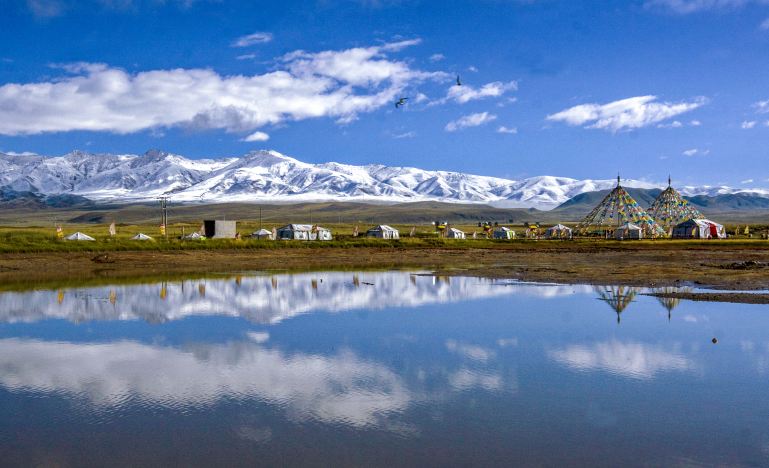

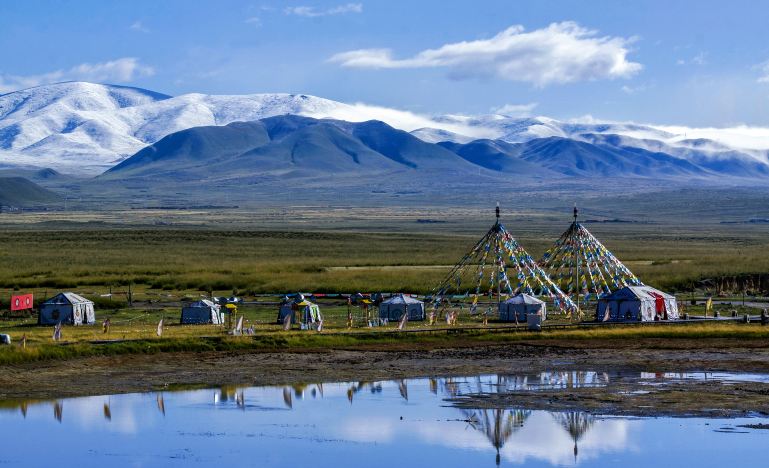
The Erlangjian Scenic Area of Qinghai Lake is located on the southern side of Qinghai Lake and is the main scenic area of Qinghai Lake. This scenic area has been developed by enclosing a section of land on the southern side of Qinghai Lake, featuring shopping centers, restaurants, hotels, and more, all designed in unique Tibetan architectural style. Additionally, it offers entertainment options such as speedboat rides, sand motorcycles, and a racetrack.
The scenic area is mainly divided into two zones: one is a large square and street next to the road, where numerous buildings and a ferry terminal are situated. The other is a narrow, sword-shaped peninsula extending several kilometers into the lake, which is also the origin of the name 'Er Lang Jian' scenic area. This peninsula concentrates various entertainment activities. When visiting the Er Lang Jian scenic area, visitors generally start by walking from the main gate to explore the lakeside square and street, viewing the lake and Tibetan-style architecture, and then take a ferry to enjoy the entertainment options on the peninsula. The entire visit to the scenic area usually takes about 2 to 4 hours.
Walking from the square to the lakeside, you can see the vast blue Qinghai Lake right in front of you. A wooden boardwalk has been built along the lake, with statues of the Fuwa and the Queen Mother of the West on the east side of the boardwalk. In the lake is the site of a torpedo base, which was once the location of the 151 Torpedo Base after the establishment of the country. Therefore, the Erlangjian Scenic Area is also known as the 151 Scenic Area.
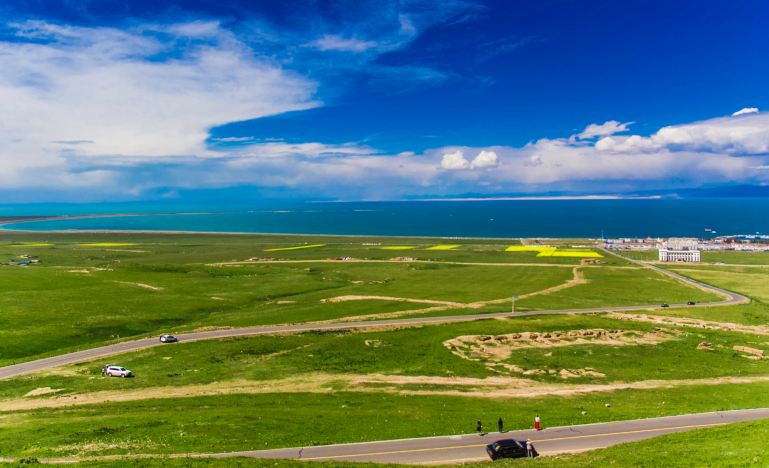


Recommended Restaurants at Qinghai Lake
1. Xihai Food City - Building 21, Rural Customs and Culture Town, Erlangjian Scenic Area, Gonghe County
2. Yiwei Fresh Pot - Gonghe County, Erlangjian Scenic Town Square
3. Many social restaurants in the Erlangjian Scenic Area of Qinghai Lake
Drive to Chaka Salt Lake after lunch
Chaka Salt Lake is a salt field with a history of over three thousand years. The lake water has a high salt content, crystallizing naturally into a white lake surface that reflects the sky, clouds, and mountains on the opposite shore, creating a beautiful scenery. Visitors can also walk barefoot on the lake surface to watch and photograph their reflections, resembling a realm of sky.
Chaka Salt Lake has a high degree of crystallization in sunny weather, where you can see a thin layer of brine covering the pure white salt lake, presenting a clear and pristine landscape with reflections. In the sculpture area of the scenic spot, you can see the stone sculpture of the Salt Lake Guardian Goddess. Besides this sculpture, there are about a dozen other massive sculptures, all made of salt, depicting figures such as Maitreya Buddha and Genghis Khan.
Walk along the pathway to the edge of the lake, and you will see the pure white Chaka Salt Lake. Here, you can take off your shoes and walk barefoot into the lake, enjoying the playful experience. In the middle of the lake, there is a railroad extending into the water, with the starting point being the place to take a small train that can take you deeper into the lake, where the scenery is even more pristine.



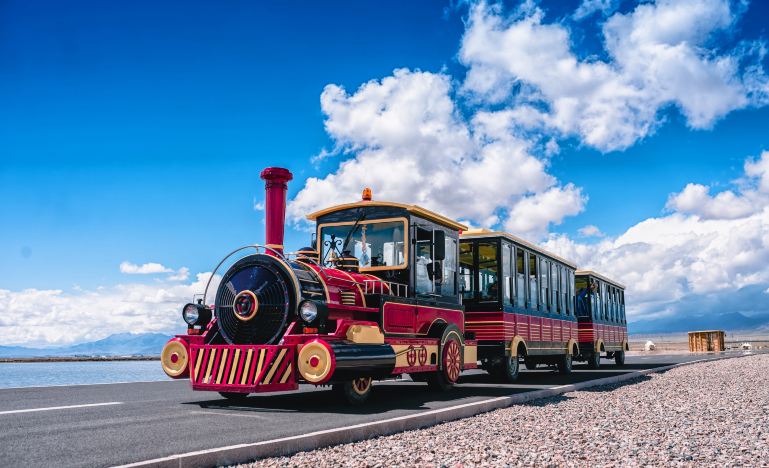 DAY 3 【Gobi Desert and Lakes Coexist】 Delingha — 315 U-shaped Road — Ustu Water Yadan Geological Park (includes shuttle bus) — Dongtai Jineer Lake — Dachaidan Town 【If you choose to upgrade to Charkhan Salt Lake, the itinerary changes to Delingha — Xiaochaidan Lake — Charkhan Salt Lake — Dachaidan】
DAY 3 【Gobi Desert and Lakes Coexist】 Delingha — 315 U-shaped Road — Ustu Water Yadan Geological Park (includes shuttle bus) — Dongtai Jineer Lake — Dachaidan Town 【If you choose to upgrade to Charkhan Salt Lake, the itinerary changes to Delingha — Xiaochaidan Lake — Charkhan Salt Lake — Dachaidan】
315 Most Beautiful Highway
National Highway 315 is a road that stretches from Xining, Qinghai to Kashgar, Xinjiang, with a total length of 3,063 kilometers. At the same time, National Highway 315 has been praised by netizens as the "Chinese version of Route 66," and it can be said to be one of the most beautiful highways in China. The U-shaped road that crosses the desert along the way is particularly striking.
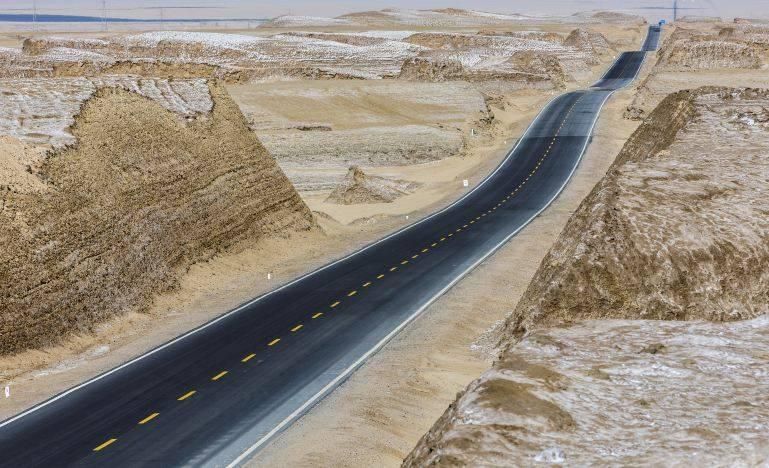
The Usut Water Yadan Geopark is a unique geological landscape of water yadan formations. As the surface of Lake Jinaier rises, it gradually submerges the northern edge of the yadan group, creating unique water yadan formations that are magical and mysterious.
Currently, there are very few visitors, and the scenic area is also very large, so you need not worry about crowds. You can enjoy it to the fullest and take your time exploring. From the dawn filled with rosy clouds to the twilight at dusk, the scenery feels like a dream. The sunlight shines on the water Yadan, creating a golden hue, and the stone pillars along with their reflections seem to float in mid-air, resembling a magical castle suspended in the air.
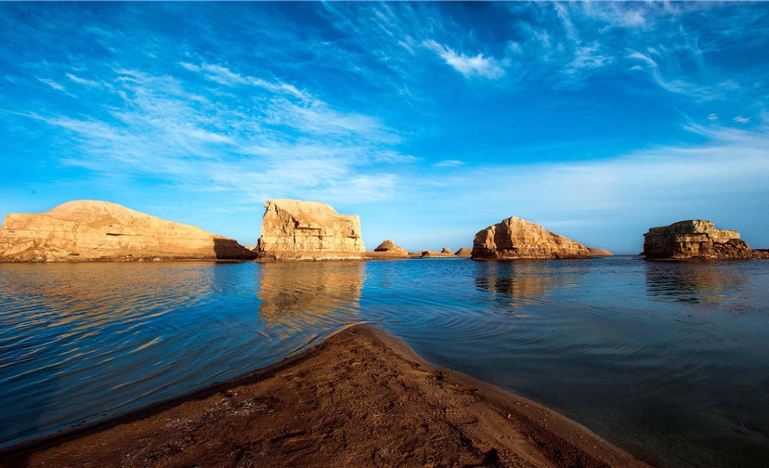

Dongtaijinaer Lake is located in Golmud City, within the Qaidam Basin. It is a large lithium ore deposit primarily consisting of brine, which also creates the breathtaking blue scenery of Dongtaijina Lake.


DAY4【Check-in at the same lake as the little red flower】Dachaidan Town—Dachaidan Emerald Lake—Yangguan Ruins (including shuttle bus)—Dunhuang
Emerald Lake is located ten kilometers northwest of the town of Dachaidan, on the northeast side of the Yikezhai Damu Lake, and belongs to the Haixi Mongol and Tibetan Autonomous Prefecture. It was originally a mining area for the salt lake mining team of the Dachaidan Chemical Factory. The lake water is clear blue in the sunlight, resembling emerald, hence the name "Emerald Lake."
When the Emerald Lake is calm, the water spreads out like a mirror, reflecting the blue sky, white clouds, and the snow-capped peaks of the Qaidam Mountains. The scenery surpasses that of Chaka Salt Lake, breathtakingly beautiful, and one can only truly appreciate it by being there.


The Yangguan Ruins, also known as the Yangguan Museum, are located on the western side of Dunhuang City, about 60 kilometers by car from the city center. It is a scenic area built on the foundation of the ancient Yangguan Ruins. The area features some replica buildings from the Han Dynasty and several exhibition halls that display numerous artifacts from the ancient Silk Road. Visitors can view the artifacts and architecture, take photos with the ancient Yangguan Ruins, and stroll along the street of residential houses in the scenic area to purchase souvenirs.
Yangguan is renowned for the famous ancient poem "I urge you to drink one more cup, for beyond Yangguan there are no old friends," and it has long been a significant town on the Silk Road. Today, the Yangguan ruins are a stop on the western route of Dunhuang, and most tourists traveling along this route will come here to see the famous pass and beacon, usually spending about 1-2 hours to explore.
When visiting the Yangguan Ruins, the first stop is the Yangguan Museum, featuring architecture modeled after the Han Dynasty. Inside, there are exhibition halls for the Two Passes of Han, the Silk Road, the Yangguan Research Institute, Han-style archways, ancient soldier barracks, the Yangguan Governor's Office, a reconstructed Han-style city gate, a street of Han-style residences, and a tourism handicrafts exhibition and sales center, all of which can be visited one by one. After the tour, head to the Yangguan Beacon Tower at the end of the scenic area, which marks the location of the ancient Yangguan relics. This is a great spot for taking photos, and the thousand-year-old ruins set against the backdrop of the Gobi Desert are truly spectacular.
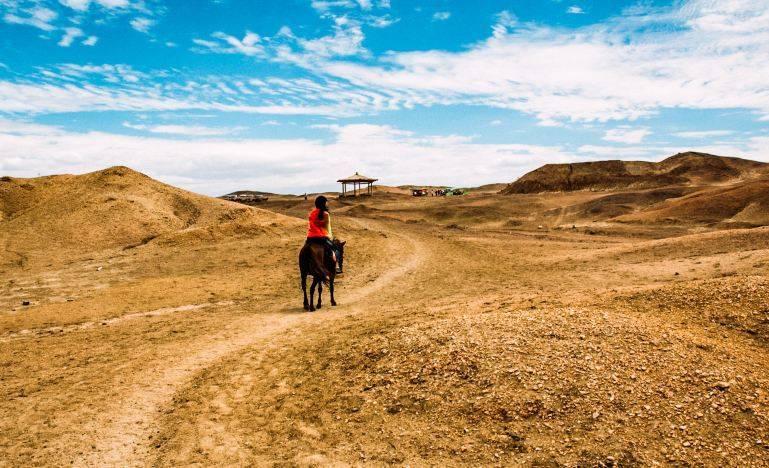


DAY 5 Dunhuang - Mogao Caves - Mingsha Mountain and Crescent Moon Spring - Dunhuang
Drive to Mogao Caves.
The Mogao Caves, also known as the Thousand Buddha Caves, are located on the southeastern side of Dunhuang city. The caves were first constructed during the Sixteen Kingdoms period of the Eastern Jin dynasty and took a millennium to carve, continuing until the end of the Yuan dynasty. They house a vast number of murals, caves, cultural relics, and more, making it a world-renowned site for Buddhist art. Here, visitors can appreciate the grand and richly detailed cave and mural art, as well as learn about the development of Buddhism in Dunhuang over a thousand years through guided explanations and film displays, making it a must-visit destination in Dunhuang.
The current Mogao Caves scenic area consists of the Mogao Caves Digital Exhibition Center and the Mogao Caves themselves, both of which are sold as a combined ticket and are not available for separate purchase. Since September 11, 2014, the scenic area has implemented a reservation system for visits; tourists must first reserve tickets via phone or online, and visit according to the reserved time slot. A maximum of 6,000 people are allowed to enter each day.


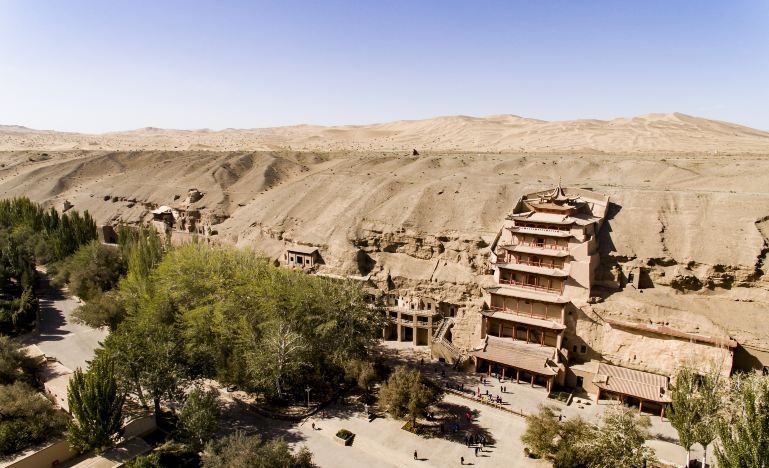
Mingsha Mountain and Crescent Spring is located south of Dunhuang city. Here, the sand dunes coexist with the spring water and has been known as a "desert wonder" throughout history, making it one of Dunhuang's landmarks. You can climb Mingsha Mountain, overlook Crescent Spring, and enjoy the sunset over the vast desert from the mountain top, experiencing the desolate grandeur of the Northwest desert.
Although water and fire have never coexisted, Crescent Spring is peacefully situated amidst this desert of sand dunes. Crescent Spring is located at the foot of Mingsha Mountain, surrounded by sand hills. Due to the geographical conditions, when the wind blows, the sand does not flow down the mountain but instead moves up the slope, which is why Crescent Spring is never buried by sand and is known as the "Eye of the Desert."
The sand dunes of Mingsha Mountain are formed by the accumulation of flowing sand. From a distance, the undulating dunes create a magnificent view. It is recommended to arrange the visit in the afternoon, which not only helps avoid the intense heat of the desert at noon, but also allows you to climb to the top of the mountain at sunset to gaze at the distant sea of sand and the Crescent Lake below, enjoying a beautiful sunset.
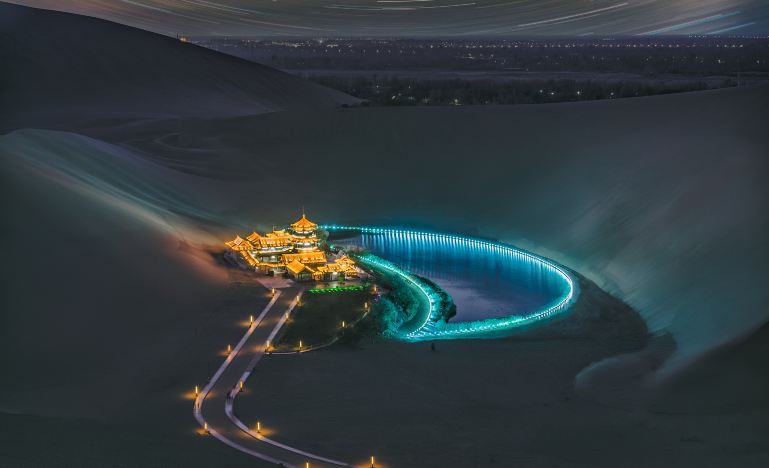

DAY6 【Hero's Spirit at Jiayuguan】 Dunhuang—Child of the Earth & Boundless—Jiayuguan Pass City—Rainbow Danxia Geological Park (if the itinerary is too tight, adjust to travel the next day)—Zhangye
Enjoy breakfast at the hotel and head to the Child of the Earth.
Son of the Earth is located on the Hongshanpo Gobi Desert in Guazhou County. It is a large outdoor thematic sculpture primarily made of red sandstone, utilizing 3D scanning to obtain model data for 3D carving. The sculpture is approximately 15 meters long, 4.3 meters high, and 9 meters wide.
Although it's a sculpture, it doesn't seem rigid; it looks just like a real baby: with a cute, dazed expression, tightly shut eyes, and peacefully lying down, as if nestled in a mother's embrace, sleeping serenely. We humans are like the children of Mother Earth; we can only feel such tranquility in her arms. Therefore, the designer of this sculpture hopes to raise awareness of the importance of protecting the Earth through the craftsmanship of the sculpture.
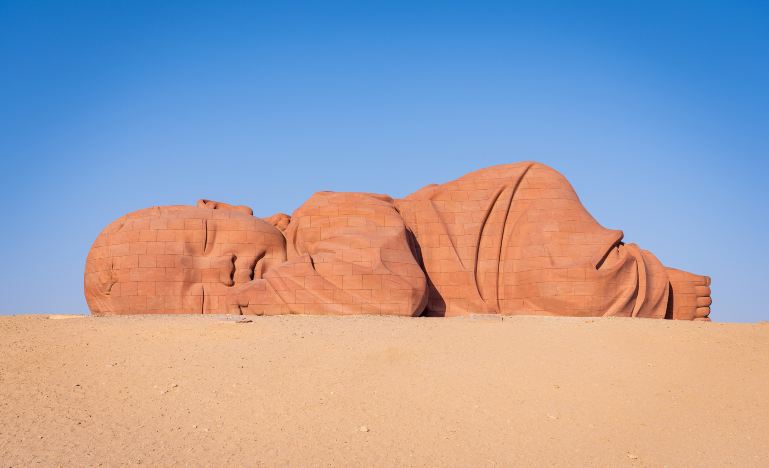

The Jiayuguan Fortress is located 5 kilometers west of Jiayuguan City, and this is the western section of the Great Wall of the Ming Dynasty. The fortress was initially built during the Ming Dynasty.
The Jiayuguan Pass Castle is located within the Jiayuguan Cultural and Scenic Area. The entrance ticket is a general admission ticket, which requires you to visit the entire scenic area. The area is not too large, with an overall perimeter of approximately 4 kilometers, and you can walk around inside. If you are not in good physical condition, you can rent a bicycle at the entrance to explore the area.
The entrance is on the east side. Upon entering, the first thing you will see is the Black Mountain Stone Carving Group, a collection of stone carvings created by modern stonemasons that showcase the history and culture of Jiayuguan. The Black Mountain Stone Carving Group consists of seven zones for visitors to explore: the Celebrity Inscription Garden, the Ancient Poetry Garden, the Chronicle Garden, the Story Garden, the Guerrilla General Stone Carving Garden, the Wei and Jin Tomb Brick Mural Stone Carving Garden, and the Black Mountain Stone Carving Garden.
Continuing forward, you can see the Jiayuguan Great Wall Museum, which is a museum themed around the historical culture of the Great Wall. The facilities inside are advanced, showcasing the history, culture, and relics of the Great Wall and Jiayuguan.
Moving forward, you will reach the core area in the west. Before entering the city gate, you can first visit the Jiu Yan Spring Lake on your left. The "Jiu Yan Spring" has lush aquatic plants and beautiful scenery, making it a great place for ancient troops to raise horses and guard the borders. The current Jiu Yan Spring shimmers with clear, bottom-visible water. The beauty of the "Jiu Yan Spring" lies in its tranquility, calm and undisturbed.


The Zhangye Rainbow Danxia Geopark is located in Linze and Sunan counties at the northern foot of the Qilian Mountains. The park is 40 kilometers east of Zhangye city and 20 kilometers north of Linze County. The total area of the park is 50 square kilometers, with a visitor activity area of 4 square kilometers. It is currently recognized as a World Geopark and a national 5A-level tourist attraction. Within the park, there are seven scenic spots including the Colorful Sea of Clouds, Colorful Fairyland, Colorful Brocade, Colorful Rainbow, Wohu Gorge, Colorful Ao River, and Wanshang Earthen Forest Valley, along with more than 30 landscapes such as the Divine Dragon Playing with Fire, Ling Monkey Watching the Sea, Many Monks Praying to Buddha, Divine Turtle Asking Heaven, Golden Toad Asking the Way, Big Scallop, Colorful Screen, Sleeping Beauty, and Wohu. This area is a highly complex zone of colorful hills and Danxia landforms.
The colorful hills are renowned for their vibrant colors, interwoven layers, magnificent momentum, and spectacular scenery. The Wansxiang Soil Forest Valley Danxia Landform Scenic Area features peaks resembling a forest, with a blend of sparse and dense formations, harmonious arrangements, uniquely shaped profiles, and a stunning craftsmanship, embodying grandeur, danger, the extraordinary, beauty, and tranquility all in one.


DAY 7 【Eastern Switzerland】 Zhangye—Biandoukou—Qilian Grassland—Xining
Enjoy breakfast at the hotel, then drive to Biandukou.
Biandukou Eco-Leisure Tourism Area, abbreviated as Biandukou Scenic Area, is located in the southeastern part of Minle County, in the heart of the Qilian Mountains, with an altitude of about 2800 meters. The summer high temperature does not exceed 30ᄚC, while the winter low temperature can reach minus 20ᄚC. The natural scenery in and around the area is exquisite, featuring vast fields of rapeseed flowers, highland pastures, Daba Valley, the Shifo Rock Paintings, Niangniang Tomb, Black Wind Cave, and Zhuge Stele, among other stunning landscapes. The cultural attractions are captivating, with well-equipped recreational facilities including international self-driving tourist camps, capsule hotels, motels, barbecue cabins, grassland camping bases, and ecological horse trails. The service quality is outstanding, meeting the needs of tourists for food, accommodation, transportation, sightseeing, shopping, and entertainment.
The Qilian Grassland is one of the six major grasslands in China, vast and boundless, covered with lush green grass. It harmonizes with the snow-capped mountains, and the herds of horses, cattle, and sheep dotted throughout create a mesmerizing scene.



In the urban area, there are several snack streets that gather Northwest cuisine, with well-known ones like Shuijing Lane, primarily featuring grilled beef and lamb as well as specialty snacks from Northwest China. Dishes such as squeezed beef, lamb tendon salad, honey fried pork loin, Qinghai mooncakes, yogurt, sweet fermented rice, and sheep intestine noodles are all worth trying. Additionally, the award-winning roasted whole lamb, award-winning stuffed noodles, Chenggui lamb neck, Quanertou lamb offal, and Daxinjie Desiao baked lamb chops from Mazhong Restaurant are signature dishes with a distinct flavor from Qinghai.
DAY 8 【Goodbye Northwest】Xining—24-hour airport drop-off—Various locations
Enjoy breakfast at the hotel, and depending on your chosen flight schedule or train departure time, we will take you to the airport or train station!


